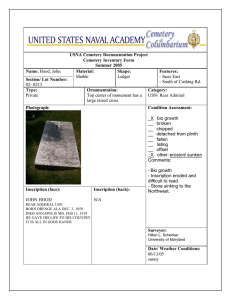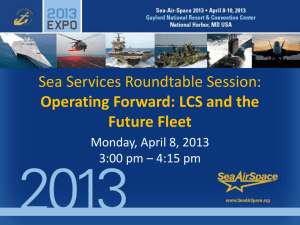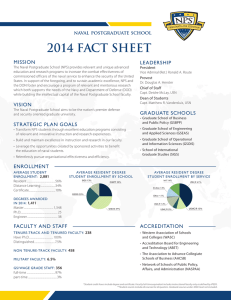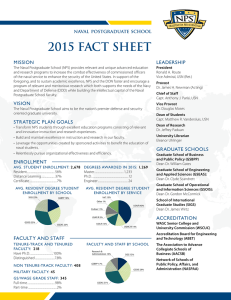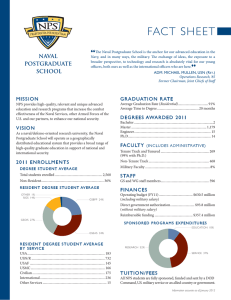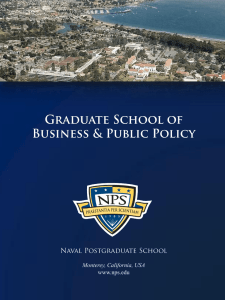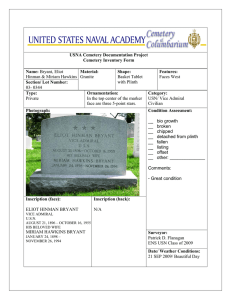NPS provides high-quality, relevant and unique advanced education and research
advertisement
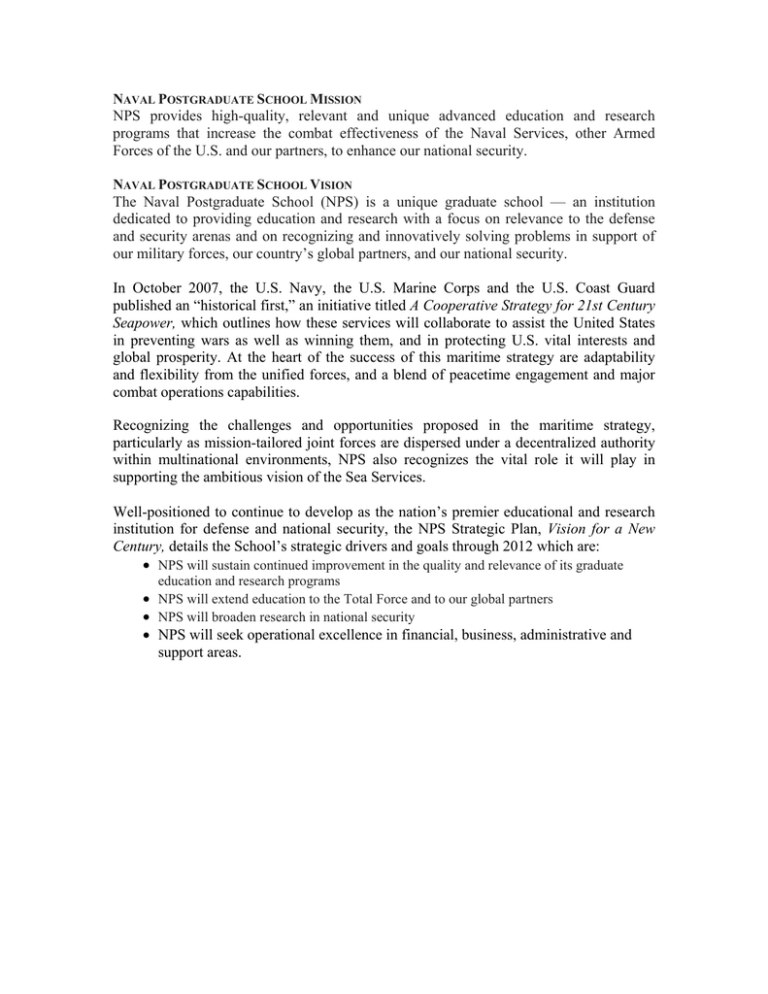
NAVAL POSTGRADUATE SCHOOL MISSION NPS provides high-quality, relevant and unique advanced education and research programs that increase the combat effectiveness of the Naval Services, other Armed Forces of the U.S. and our partners, to enhance our national security. NAVAL POSTGRADUATE SCHOOL VISION The Naval Postgraduate School (NPS) is a unique graduate school — an institution dedicated to providing education and research with a focus on relevance to the defense and security arenas and on recognizing and innovatively solving problems in support of our military forces, our country’s global partners, and our national security. In October 2007, the U.S. Navy, the U.S. Marine Corps and the U.S. Coast Guard published an “historical first,” an initiative titled A Cooperative Strategy for 21st Century Seapower, which outlines how these services will collaborate to assist the United States in preventing wars as well as winning them, and in protecting U.S. vital interests and global prosperity. At the heart of the success of this maritime strategy are adaptability and flexibility from the unified forces, and a blend of peacetime engagement and major combat operations capabilities. Recognizing the challenges and opportunities proposed in the maritime strategy, particularly as mission-tailored joint forces are dispersed under a decentralized authority within multinational environments, NPS also recognizes the vital role it will play in supporting the ambitious vision of the Sea Services. Well-positioned to continue to develop as the nation’s premier educational and research institution for defense and national security, the NPS Strategic Plan, Vision for a New Century, details the School’s strategic drivers and goals through 2012 which are: • NPS will sustain continued improvement in the quality and relevance of its graduate education and research programs • NPS will extend education to the Total Force and to our global partners • NPS will broaden research in national security • NPS will seek operational excellence in financial, business, administrative and support areas. AVERAGE ON BOARD STUDENT POPULATION BY SERVICE ALL DEGREE STUDENTS TRENDS SINCE 1998 2,400 DL 2,000 Int'l 1,600 Civilian Other Services 1,200 USA/R 800 USMC USAF 400 USN/R 0 1998 1999 2000 2001 2002 2003 2004 2005 2006 2007 2008 1998 1999 2000 2001 2002 2003 2004 2005 2006 2007 2008 USN/R 701 685 665 629 607 597 624 709 707 713 685 USAF 21 35 31 35 39 79 168 216 273 263 201 USMC 109 190 200 215 198 182 195 192 200 180 163 USA/R 97 109 102 109 98 95 116 108 132 179 163 Other Services 12 13 10 12 13 8 6 6 8 11 10 Civilian 13 12 10 13 17 30 49 41 137 93 114 142 239 261 256 272 323 323 290 275 267 230 1,095 1,283 1,279 1,269 1,244 1,314 1,481 1,562 1,732 1,706 1,566 64 95 111 180 221 247 322 541 501 600 719 1,159 1,378 1,390 1,449 1,465 1,561 1,803 2,103 2,233 2,306 2,285 International Total Resident Distributed Learning GRAND TOTALS Source: Current Resident and Non-Resident Enrollment Reports, Office of the Registrar PEAK QUARTER ENROLLMENT, SUMMER 2008 DEGREE PROGRAM STUDENT BY SCHOOL SIGS 16% GSBPP 26% SEACC 1% GSOIS 28% GSEAS 29% Full-Time Resident 272 406 563 27 SCHOOL Graduate School of Business and Public Policy Graduate School of Engineering and Applied Sciences Graduate School of Operational and Information Systems Systems Engineering and Analysis Curriculum Committee School of International Graduate Studies Total Distributed Learning 331 243 87 0 Total 603 649 650 27 324 57 381 1,592 718 2,310 AVERAGE ON BOARD 2008 DEGREE PROGRAM STUDENTS BY SCHOOL SIGS 17% GSBPP 25% SEACC 1% GSOIS 29% GSEAS 28% SCHOOL Graduate School of Business and Public Policy Graduate School of Engineering and Applied Sciences Graduate School of Operational and Information Systems Systems Engineering and Analysis Curriculum Committee School of International Graduate Studies Total Full-Time Resident 250 385 547 32 353 1,566 Distributed Learning 317 264 104 Source: Resident and Non-Resident Enrollment Reports, Office of the Registrar 34 719 Total 566 649 651 32 386 2,284 RESIDENT DEGREE STUDENTS BY SCHOOL AND SERVICE PEAK QUARTER ENROLLMENT, SUMMER 2008 SCHOOL NAVY Graduate School of Business and Public Policy Graduate School of Engineering and Applied Sciences Graduate School of Operational and Information Systems Systems Engineering and Analysis Curriculum Committee School of International Graduate Studies Total Total % MARINE CORPS AIR FORCE ARMY CIVILIAN INT'L OTHER TOTAL 134 53 24 15 3 42 1 272 253 25 18 24 13 71 2 406 231 98 112 23 9 87 3 563 1 3 23 69 710 45% 28 204 13% 17 171 11% 109 171 11% 77 103 6% 27 20 223 14% 4 10 1% 324 1,592 100% RESIDENT DEGREE STUDENTS BY SCHOOL AND SERVICE AVERAGE ON BOARD 2008 SCHOOL Graduate School of Business and Public Policy Graduate School of Engineering and Applied Sciences Graduate School of Operational and Information Systems Systems Engineering and Analysis Curriculum Committee School of International Graduate Studies Total Total % NAVY MARINE CORPS AIR FORCE ARMY CIVILIAN INT'L OTHER TOTAL 114 43 22 24 5 41 1 250 232 22 13 30 14 70 3 385 233 77 100 26 17 91 3 547 28 0 0 0 1 2 0 32 78 685 44% 20 163 10% 28 163 10% 120 201 13% 77 114 7% 26 230 15% 3 10 1% 353 1566 100% Source: Current Resident Enrollment Reports, Office of the Registrar RESIDENT DEGREE STUDENTS BY ETHNICITY Peak Quarter Enrollment Summer 2008 International (223/13%) Unknown (258/15%) AmIndian/Ala skan Native (7/0.4%) White (1105/66%) Asian American/Pacific Islander (104/5%) Black/African Hispanic/ Latinos American (111/7%) (92/5%) RESIDENT DEGREE STUDENTS BY Gender Peak Quarter Enrollment Summer 2008 Females (166/9%) Males (1734/91%) Source: Student Data Systems, Office of Institutional Research US MILITARY FORCES BY RANK AND SERVICE PEAK QUARTER ENROLLMENT, SUMMER 2008 100% 90% Rank Lt. Colonel 80% Commander Lt. Commander 70% Major Captain 60% Lieutenant 1st Lieutenant 50% 2nd Lieutenant Lt. Jr. Grade 40% Navy/R Army/R Air Force Corps - 2% 3% 3% 7% - - - 27% - - - - 69% 48% 29% 59% 1% 28% 40% 59% - - - - - 5% 7% - - 3% - 4% - - - BG 30% 20% Ensign 2% - - - CW02 - 1% - - CW03 - 1% 1% P01, 02 & 03 Technical Sgt. 10% 1st Sergeant Total 0% Navy/R Army/R Air Force - - - 1% - - - - 1% 100% 100% 100% 100% Marine Corps INTERNATIONAL MILITARY FORCES BY RANK AND SERVICE PEAK QUARTER ENROLLMENT, SUMMER 2008 100% 90% Rank 80% 70% Int'l Navy Int'l Army Colonel 0% 2% 4% - Lt. Colonel 0% 6% 12% - Commander 1% 0% 0% - 20% 0% 0% - Major 1% 27% 21% 100% Captain 1% 44% 13% - 1st Lieutenant 0% 19% 50% - Lieutenant 43% 0% 0% - Lieutenant Jr. Gra 33% 0% 0% - BG 0% 2% 0% - Ensign 1% 0% 0% - 100% 100% 100% 100% Lt. Commander 60% 50% 40% 30% Total 20% 10% 0% Int'l Navy Int'l Air Force Int'l Air Force Int'l Marines International Students by Country and Region Peak Quarter Enrollment, Summer 2008 Europe Far/Near East North America Central/East Asian & Middle East Africa Caribbean, Central & South America Australia Australia Australia Total North America Canada Mexico Total 3 3 4 3 7 Central/East Asian & Middle East Bahrain 1 Israel 1 Pakistan 4 Total 6 Africa Ethiopia Kenya Tunisia Total 1 2 1 4 Europe Azerbaijan BosniaHerzegovina Germany Greece Hungary Latvia Moldova Norway Poland Portugal Romania Spain Sweden Turkey Ukraine Kingdom Total 1 2 13 48 2 1 1 3 2 3 1 1 1 51 2 2 134 Far/Near East Brunei India Indonesia Korea Philippines Singapore Taiwan Thailand Total 1 1 1 11 3 40 7 2 66 Caribbean, Central & South America Brazil Colombia Paraguay Total Source: Current Student Enrollment, Office of the Registrar 1 1 1 3 Short Course Enrollments CCMR: Center for Civil Military Relationships 16,651 CEE: Center for Executive Education 410 16,995 361 13,874 2006 2007 2008 2006 DRMI: Defense Resource Management Institute 558 546 2006 2007 2007 2008 GSBPP: Graduate School of Business and Public Policy 430 142 143 2008 2006 2007 2008 CHDS: Center for Homeland Defense and Security GSEAS: Graduate School of Engineering and Applied Sciences 943 100 100 2007 2008 0 2006 2006 RSEP: Regional Security Education Program 2007 Source: Office of the Registrar 51,115 42,383 31,000 2006 2007 Source: Office of the Registrar 2008 2008 DEGREES CONFERRED BY ACADEMIC SCHOOL 1400 1200 1000 SEAC SIGS 800 GSOIS GSEAS 600 GSBPP 400 200 0 1998 1999 2000 2001 2002 SCHOOLS Graduate School of Business and Public Policy (GSBPP) Graduate School of Engineering and Applied Sciences (GSEAS) Graduate School of Operational and Information Sciences (GSOIS) School of International Graduate Studies (SIGS) Systems Engineering and Analysis (SEACC) 1998 1999 2000 2001 2002 2003 2004 2005 2006 2007 2008 188 160 151 159 211 173 235 230 325 331 330 259 232 258 242 250 304 273 214 293 355 254 174 238 239 234 253 218 302 299 296 329 328 77 90 107 114 105 119 169 187 180 195 227 - - - - - - - - 34 30 25 720 755 749 819 814 979 930 Total 698 2003 2004 2005 2006 2007 2008 Source: Office of Institutional Research, Student Information System 1,128 1,240 1,164 DEGREES CONFERRED ACADEMIC YEAR 2008 DEGREE TOTAL DEGREE (continued) ASTE Astronautical Engineer 1 MS Engineering Science BS Computer Science 1 MS Engineering Science (Mechanical Engineering) EE Electrical Engineering 2 MS Human Systems Integration EMBA Master of Business Administration M Executive Management M Systems Analysis MA National Security Affairs MA Sec Studies (Combating-Terrorism: 95 TOTAL 1 13 5 MS Information Operations 13 4 MS Information Systems and Operations 10 16 MS Information Technology Management 51 MS Information Warfare Systems Engineering 17 106 2 MS Leadership and Human Resources Developmen MS Management 8 MA Sec Studies (Mid East, S Asia, Sub-Saharan 26 MA Security Studies (Civil-Military Relations) 6 MA Security Studies (Defense Decision-Making 26 MS Meteorology 17 MA Security Studies (Europe and Eurasia) 13 MS Meteorology and Physical Oceanography 16 MA Security Studies (Far East, SE Asia, the 24 MS Modeling Virtual Environments and Simulation 20 MA Security Studies (Homeland Security and 65 MS Operations Research MS Mechanical Engineering 35 2 110 MA Security Studies (Security Building in Post- 1 MS Physical Oceanography 8 MA Security Studies (Stabilization & 7 MS Physics 9 MA Security Studies (Western Hemisphere) 4 MS Program Management 7 230 MS Software Engineering 2 MBA Master of Business Administration ME Mechanical Engineering 1 MS Space Systems Operations 15 29 MS Applied Mathematics 10 MS Sys Technology (Command, Control & Commu MS Applied Physics 37 MS Systems Engineering 111 MS Applied Science (Operations Research) 6 MS Systems Engineering Analysis MS Astronautical Engineering 8 MS Systems Engineering Management 7 MS Combat Systems Technology 5 MSME Materials Science and Engineering 4 MS Computer Science 54 MS Contract Management 1 MS Defense Analysis MS Defense Analysis (Irregular Warfare) 38 PHD Applied Mathematics 1 PHD Computer Science 1 4 PHD Electrical Engineering 6 36 PHD Information Sciences 1 20 MS Defense Analysis (Information Operations) MSME Mechanical Engineering 25 MS Defense Analysis (National Security Affairs) 9 PHD Modeling Virtual Environments and Simulatio 1 MS Defense Analysis (Operations Analysis) 1 PHD Physical Oceanography 2 MS Defense Analysis(Terrorist Operations & 14 PHD Physics 2 MS Electrical Engineering 60 PHD Software Engineering 3 MS Electrical Engineering (Space Systems 1 MS Electronic Warfare Systems Engineering 12 MS Engineering Acoustics 12 Grand Total Source: Student Data Systems, Office of Institutional Research 1,510 NPS HALL OF FAME HONOREES The NPS Hall of Fame recognizes the accomplishments of NPS's most distinguished alumni and friends who, through the attainment of positions at the highest levels of public service, have made the greatest contributions to society, their nations Honorable Dan Albert (Presented 23 Feb 07) Admiral Wayne E. Meyer (Ret) (Presented 23 Feb 06) Admiral James D. Watkins (Ret) (Presented 20 Apr 05) General John A. Gordon (Ret) (Presented 16 Sep 04) Admiral Henry Mauz (Ret) (Presented 19 Nov 03) Vice Admiral Arthur Cebrowski (Ret) (Presented 13 Jan 03) Professor Pao Chuen Lui (Presented 28 Mar 02) The Honorable James Roche, Captain USN (Ret) (Presented 27 Sep 01) The Honorable Thomas White (Presented 27 Sep 01) DISTINGUISHED ALUMNI HONOREES The NPS Distinguished Alumni Program recognizes any alumnus/a of the Naval Postgraduate School who has made distinguished contributions to a branch of learning associated with national security, has rendered distinguished service to some aspect of their national security, or has made a distinguished professional achievement Admiral Stanley Arthur, USN Captain Jeffrey Bacon, USN (Ret) (Presented 14 Oct 06) Vice Admiral Roger F. Bacon, USN (Ret) (Presented 1 July 06) Vice Admiral Phillip Balisle, USN Rear Admiral Stanley Bozin, USN (Presented 2 Mar 06) Vice Admiral Nancy E. Brown, UNS (Presented 5 Mar 07) Vice Admiral Arthur Cebrowski, USN Rear Admiral Philip J. Coady Jr., USN (Ret) (Presented 27 Mar 06) Rear Admiral Patrick W. Dunne, USN Rear Admiral James B Greene Jr. USN (Ret) (Presented 17 May 06) Rear Admiral Charles S. Hamilton II, USN (Presented 17 May 06) Rear Admiral Michael A. Brown, USN (Presented 13 July 06) Captain Daniel W. Bursch, USN (Ret) (Presented 29 May 06) Commander Sandra K. Chachula, USN (Ret) (Presented 1 Sep 06) Rear Admiral Dan W. Davenport, USN (Presented 8 June 06) Vice Admiral Mark E. Ferguson, III, USN (Presented 19 Dec 2008) Vice Admiral Lee F. Gunn, USN (Ret) (Presented 18 Apr 06) Rear Admiral Cecil E. Haney, USN Rear Admiral Elizabeth A. Hight, USN Captain Sam Houston, USN (Ret) (Presented 14 Jan 06) Captain Wayne P. Hughes, Jr., USN (Ret) (Presented 29 May 06) Vice Admiral Harvey E. Johnson, Jr., USCG (Ret) (Presented 11 May 06) Lieutenant General Richard S. Kramlich, USMC (Presented 11 Nov 06) Captain Donald M. Layton, USN (Ret) (Presented 22 Nov 06) Rear Admiral Michael A. LeFever, USN (Presented 30 May 06) CAPT Michael Lopez-Alegria, USN (Presented 15 Nov 07) Vice Admiral Justin McCarthy SC, USN (Presented 7 Feb 06) Rear Admiral Archer M. Macy, Jr., USN (Presented 31 Jan 06) Vice Admiral Michael Mullen, USN (Presented 29 Mar 02) Rear Admiral John M. Kelly, USN (Presented 23 May 06) Rear Admiral William Landay III, USN (Presented 16 Feb 06) Lieutenant General Chan Lee, ROKAF (Presented 20 Sep 06) Vice Admiral Keith W. Lippert, USN (Presented 7 July 06) Professor Pao Chuen Lui (Presented 29 Mar 02) Rear Admiral Timothy J. McGee, USN (Presented 11 May 06) Rear Admiral Wayne Meyer, USN Admiral Eric T. Olson, USN (Presented 4 September 08) Rear Admiral Kenneth Slaght, USN Vice Admiral Patricia A. Tracey, USN (Ret) (Presented 21 Mar 06) Major General Michael A. Vane, USA (Presented 12 Sep 06) The Honorable Thomas White, Secretary of the Army Captain John A. Zangardi, USN (Ret) (Presented 9 Nov 06) The Honorable James Roche, Captain, USN (Ret) Vice Admiral Stanley Szemborski, USN (Presented 7 Feb 06) Lieutenant General Thomas R. Turner, USA (Presented 19 Dec 2008) General William S. Wallace, USA (Presented 23 Mar 07) COL Jeff Williams, USA (Ret) (Presented 3 Apr 08) Faculty by Rank Rank GSBPP GSEAS GSOIS 5 1 SIGS RESEARCH ADMIN TOTAL Tenure Track Distinguished Professor 6 Professor 10 52 28 6 6 Associate Professor 15 25 27 9 4 1 103 80 Assistant Professor 0 Instructor 1 Research Associate 1 1 Research Assistant 11 Visiting Professor Administration 7 10 4 2 1 11 41 6 1 1 37 95 69 26 Research Professor 3 8 17 Research Associate 1 26 Research Assistant 2 Total 2 8 10 12 9 248 3 24 1 56 31 7 16 2 83 26 22 5 32 1 88 8 5 2 6 3 1 Non-Tenure Track Research Instructor 21 Senior Lecturer 2 Lecturer 36 25 30 32 2 2 127 Visiting Faculty 10 4 3 - - - 17 Administration 1 1 8 19 29 Other Faculty 6 1 1 Total 55 98 112 58 80 25 428 Grand Total 92 193 181 84 92 34 676 Graduate School of Business and Public Policy (GSBPP) Graduate School of Engineering and Applied Sciences (GSEAS) Graduate School of Operational and Information Sciences (GSOIS) School of International Graduate Studies (SIGS) Source: Office of Academic Planning as of Sept 2008 TENURE VS. NON-TENURE TRACK FACULTY BY SCHOOL NON-TENURE TRACK TENURE TRACK SCHOOL TOTAL Graduate School of Business and Public Policy (GSBPP) 55 37 92 Graduate School of Engineering and Applied Sciences (GSEAS) 98 95 193 112 69 181 58 26 84 Research Institutes & Centers 80 12 92 Administration 25 9 34 428 248 676 Graduate School of Operational and Information Sciences (GSOIS) School of International Graduate Studies (SIGS) TOTAL FACULTY DISTRIBUTION BY SCHOOL ADMINISTRATION (5%) GSBPP (14%) RESEARCH (14%) SIGS (12%) GSEAS (29%) GSBPP (27%) Source: Office of Academic Planning as of Sept 2008 TENURE TRACK/NON-TENURE TRACK FACULTY TRENDS SINCE 2000 450 428 400 369 350 301 300 288 250 200 236 188 231 224 240 238 240 283 242 241 236 248 216 189 150 100 50 0 2000 2001 2002 2003 Tenure Track 2004 2005 Non-Tenure Track Source: Office of Academic Planning 2006 2007 2008 FACULTY & STAFF 2008 BY ETHNICITY African American Asian & Pacific Islander American Indian Hispanic White Unknown TOTAL GS 38 3 55 33 235 - 364 WG 0 0 1 1 4 - 6 NSPS 5 0 7 2 75 - 89 FACULTY 4 1 41 13 447 170 676 47 5 110 49 911 170 1,135 TOTAL FACULTY AND STAFF 2008 BY GENDER 100% 80% 60% 40% 20% 0% GS WG Females NSPS Males GS = General Schedule Employees WG = Wage Grade Employees NSPS = National Security Personnel System Source: Equal Employment Opportunity Office FACULTY NPS is a member of CENIC, the Corporation for Education Network Initiatives in California, and has access to cost-effective, high-bandwidth networking across California, as well as the nation and the world, to support its education and research mission. SIZE OF NPS SYSTEMS Multiple Networks EDU – nps.edu - CENIC HPR – hpr.nps.edu - CENIC MIL – nps.navy.mil - DREN Public (for guests) – public.nps.edu - CENIC Wireless DODNet – Monterey DOD Interconnect – DMDC, PERSEREC, DLI, NRL, FNMOC, NPS PACBell Research Network Accounts: (User Accounts) Staff and Faculty: 1,913 Resident Students: 1,958 Distance Learning Students: 1,715 Non-entity Accounts: 350 Web services: Total Page views Annually Extranet: 14,112,443 Intranet: 4,969,060 External E-Mail Received: 30 million per year Approximately 70,000 emails/day classified as spam using Barracuda Approximately 12,000 daily alerts within our Intrusion Detection System Active Phone Lines: 500 digital; 100 VoIP; 2,400 analog High Performance Computing (HPC) Number of Linux workstations: 80 Number of Linux users: 250 Number of HPC Supercomputers: 12 racks, with 180 nodes and 708 processors. Number of Supercomputer users: 50 Current HPC disk space: 30 terabytes Educational Technology Forty-Eight Point Multipoint Control Unit (MCU)/Video Bridge: 1 ISDN Video-Conferencing Circuits: 165 Multimedia Presentation Systems: 100+ Video-Conferencing Facilities: 2 Video Tele-Education Systems: 7 5,808 Class hours recorded and streamed via the Internet in FY08 3,358 Class hours recorded and delivered through web-conferencing system in FY08 380,317 Logins to the Learning Management System in FY08 3,780 Courses hosted on the Learning Management System Source: ITACS INFORMATION TECHNOLOGY AND COMMUNICATIONS SERVICES PARTNERSHIPS Monterey Peninsula Department of Defense Net Regional DoD consortium with physical infrastructure linking Fleet Numerical Meteorology and Oceanography Center, Naval Research Laboratory, Defense Language Institute, Defense Manpower Data Center, Naval Postgraduate School, PERSEREC Corporation for Education Network Initiatives in California (CENIC) State research and education network (CalREN) links University of California campuses and system, California State University campuses and system, University of Southern California, Cal Tech, Stanford University and provides connectivity to other national high-speed networks such as LambdaRail and Internet2 Defense Research Engineering Network (DREN) DoD's recognized research and engineering network. Robust, high-capacity, low-latency nation-wide network that provides connectivity between and among the HPCMP's geographically dispersed High Performance Computing (HPC) user sites, HPC Centers, and other networks. Internet2 National high-speed, high capacity network; U.S. university-led consortium with partners in industry and government accelerating development of tomorrow's internet. Navy Higher Education IT Consortium Naval Postgraduate School, Naval War College, and Naval Academy CIOs working to develop higher education-based collaborations to maximize effectiveness of technology use at each of the three institutions. Center for Asymmetrical Warfare; Pt. Mugu, CA Educational and research partners of NPS that have established links to our distributed technology tools; Synchronous Collaboration System, Learning Management System, Video capture, Video editing system and Podcasting. This partnership has lead to other educational partnerships to include Commander Navy Installation Command (CNIC) which will be using NPS” Synchronous Collaboration Tool to deliver educational content to over 150 students. University California San Diego—CalIT2 Membership in the Optiputer initiative serving as the optical networking foundation for research and supercomputer collaborations between NPS and more than two dozen universities around the world DOD Educational Information Security Working Group 23 DOD educational institutions that focus on network and information security - collaboration electronically throughout the year to solve security related problems CineGrid Interdisciplinary community focused on the research, development, and demonstration of networked collaborative tools to enable the production, use and exchange of very-high quality digital media over photonic networks Source: ITACS Dudley Knox Library 2007 Highlights Launched DKL Alumni Access portal to provide access to selected databases and full-text resources to qualified NPS alumni Upgraded 4 group studies and 2 conference rooms with interactive technologies to improve student access to collaborative work spaces Continued transition toward 24/7 electronic access to major Acquired several major backfiles of e-journals and e-books to improve 24/7 access and free up physical library space for study spaces Balanced the FY2007 budget after $100,000 budget cut, through belt tightening, careful planning, and with help from end of year funds Refreshed public interface to the online catalog, BOSUN, and added improved functionality Continuous improvements and enhancements to DKL website (http://www.nps.edu/Library/index.html) Worked with ITACS on major network migration and wireless upgrade Replaced printers with 9 multi-function devices for networked copying, faxing, printing, and scanning to email Restricted Resources and Services unit participated in a pilot project to make NPS content more broadly available to users on limited/classified networks Provided data and information to campus leaders, accreditation teams, and program reviews, as well as to national library reporting agencies, to show library’s ‘value’ and to quantify support of NPS instruction and research mission Library instruction sessions were well-attended and expanded to better meet the 24/7 needs of students anywhere/anytime, through means such as flash presentations available on the library’s web site Business librarian conducted a “pilot project” in which she “embedded” in GSBPP Began library space remodel to create better spaces for patrons, staff, and collections/equipment LIBRARY RESOURCES ADDED PER YEAR 23,209 21,465 18,839 17,599 15,746 15,215 10,637 9,004 8,124 7,848 7,995 6,258 6,176 1,776 10 2001 1,116 2002 Books 2003 2004 2005 2006 2007 Electronic Resources (Digital Archives & Internet) 2008 ANNUAL TOTAL GATE COUNT 285,540 300,000 292,466 264,786 256,818 Number of library users 250,000 200,000 244,064 232,418 184,109 200,185 150,000 100,000 50,000 0 2002 2003 and removal 2004 of gate2005 2006 2007FY 20082008 *Gate2001 count affected by construction for extended periods during NPS BORROWING COMMUNITY 3000 2500 2000 1500 1000 500 0 2001 2002 2003 2004 Students 2005 Faculty 2006 Staff 2007 2008 ITEMS CIRCULATED PER YEAR 35,000 30,000 31,541 32,521 28,749 25,217 25,924 22,873 25,000 21,579 20,000 15,000 10,000 5,000 0 2002 2003 2004 2005 2006 2007* 2008 * Beginning in 2007, circulation statistics no longer included interlibrary loans. INTERLIBRARY LOANS Number of Requests per Year 5,000 4,495 4,578 4,633 4,734 2007 2008 4,473 4,000 3,000 2,904 3,186 2,000 1,000 0 2002 Top 10 Downloads 2007 Submarine Bibliography Midway Bibliography Version 2 CBN Terror Bibliography Seamines Bibliography Version 2 Intelligence Bibliography Midway Bibliography Version 3 PME Bibliography Deep Web Presentation Seamines Bibliography Version 1 DTIC Handout 2003 2004 2005 2006 Top 10 Search Terms - 2007 (number of sessions & search term ) 2,018 terrorist groups 357 aljihad 354 april calendar 2007 1,200 november calendar 2007 829 2007 october calendar 317 terrorist group 679 2007 august calendar 297 comnavairfor instruction 287 navy clip art 623 naval postgraduate schoo 542 hamas 283 2007 september calendar 436 citation wizard 245 terrorist group profiles 417 nps library 243 islamic jihad union 237 2007 july calendar 388 2007 november calendar 361 dudley knox libarary 228 air force clip art Workshops Offered 200 181 180 168 166 160 168 142 140 120 100 80 60 40 17 14 16 16 16 20 0 2004 2005 2006 Workshops 2007 2008 Workshop average attendance Presentations to Groups 3500 3,092 2,996 2,878 3000 2500 2000 1500 1000 500 192 207 199 0 2006 Group presentations 2007 2008 Group presentation participants ACADEMIC FACILITIES FUNCTION QUANTITY DESCRIPTION Traditional classroom or conference room with multi-media projection system and instructor computer. This is the minimum baseline technology for all traditional classrooms. Baseline classroom with AC electrical and LAN ports run to each seat for connecting laptops. TOTAL COST $16,050 Baseline Classroom 70 Laptop-Ready Classroom 1 Computer-Equipped Classroom 10 Baseline classroom or lab with networked PCs and AC at each student seat. $74,403 VTE Classroom 5 Video tele-education classroom. Traditional style classroom augmented with videoconferencing technology, specialized video display system, instructor PC, document camera, vcr, microphones, loudspeakers, and audiovisual routing matrix. $118,400 VTE Studio 3 Video tele-education teaching studio. Enhanced version of Type 3a VTE Classroom, but without seats for local students. Used for VTE programs with only remote students. $131,400 LCR Windows 15 LRC Unix/Linux 3 Public Learning Resource Centers. Equipped with networked computers for student use, instructor computer, networked printer. Commonly used as a computer classroom on an irregular basis. Public Learning Resource Centers. Equipped with networked computers for student use, instructor computer, networked printer. Commonly used as a computer classroom on an irregular basis. Source: Instructional Technology $21,050 $103,470 $143,650 Total Operations & Military Salary Budget by Source FY 2008 Military Staff Salary 1% Direct Salaries (Faculty and Staff) 11% Reimbursable Authorization 36% Military Faculty Salary 1% Direct Authorization 22% Student Salary 29% Budget Item $ Allocated (in millions) Reimbursable Authorization $ 161.7 Student Salary $ 133.7 Direct Authorization $ 102.6 Military Faculty Salary $ 6.1 Military Staff Salary $ 4.3 Direct Salaries (Faculty and Staff) $ 52.9 Total $ 461.3 SPONSORED PROGRAM EXPENDITURES 2008 By Sponsor in Thousands of Dollars Other (3%), $2,551 Industry (1%), $726 Other Federal (6%), $5,347 Air Force (4%), $3,511 Army (8%), $7,904 NSF (4%), $3,752 Joint (11%), $10,314 Navy (38%), $36,196 Defense (27%), $26,110 SPONSORED PROGRAM EXPENDITURES 2008 By NPS Organization in Thousands of Dollars Institutes (18%), $20,889 GSBPP (7%, $7,960 GSEAS (28%), $32,358 Other (10%), $11,780 SIGS (19%), $22,754 GSOIS (18%), $21,468 SPONSORED PROGRAMS EXPENDITURES TRENDS SINCE 2003 in THOUSAND DOLLARS $90,000 $80,000 $70,000 $60,000 $50,000 $40,000 $30,000 $20,000 $10,000 $0 2003 2004 2005 Education 2006 Service 2007 2008 Research Education Service 2003 $18,489 $155 2004 $21,473 $273 2005 $31,185 $501 2006 $23,395 $3,091 2007 $18,301 $20,285 2008 $12,060 $19,846 Research $47,965 $62,050 $48,744 $54,875 $64,353 $83,302 Source: Research and Sponsored Programs Office
